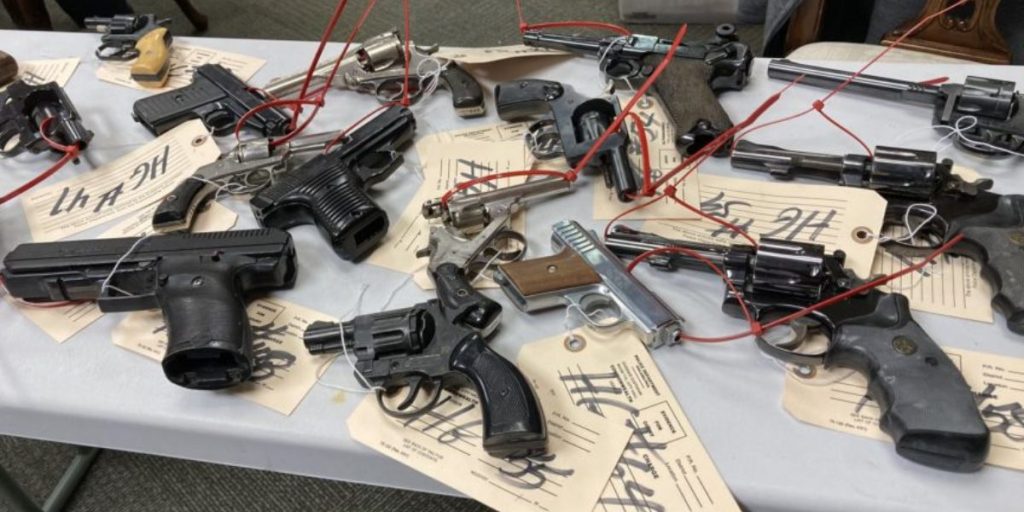Firearm sales in the United States have reached all-time highs in recent years, and the continued availability of firearms may be fueling an increase in gun crime.
Arizona, known for its rugged landscapes and independent spirit, also boasts one of the highest rates of gun ownership in the United States. While many residents argue that owning firearms is a constitutional right and vital for self-defense, the proliferation of guns comes with its share of challenges, raising concerns about public safety.
When firearms are found at a crime scene or taken from a suspect, they are frequently submitted to the Bureau of Alcohol, Tobacco, Firearms, and Explosives for tracing. In these circumstances, the ATF aids criminal investigations by utilizing serial numbers and other markings to determine when and where a handgun was initially obtained — and over the previous 12 years, firearm-related offenses have consumed an increasing percentage of government resources.
Between 2010 and 2022, the ATF traced 174% more guns, from 145,600 to 399,400, with increases ranging from 3% to 18% in a single year. The majority of homicides in the United States are committed with a firearm, and the national homicide rate has increased by more than half during the same time period.
While not all guns traced by the ATF were used in a crime, and not all firearms used for unlawful purposes are traced—federal tracing data offers useful insight into trends and geographic patterns related to gun violence in the United States.
Gun tracing in Arizona are rising rapidly, mirroring the national trend. In 2022, the ATF traced 11,885 weapons seized in the state, up from 5,477 in 2010. In 12 of the previous 13 years, the number of firearm tracings per 100,000 inhabitants in the state exceeded the comparable national average.
As of 2022, the most recent year for which data is available, the ATF traced 161.5 seized weapons per 100,000 persons in the state, ranking ninth among states.
This article explores the reasons behind Arizona’s high gun ownership rates, examines the negative impacts, and suggests potential solutions for a balanced approach.
| Year | Firearm tracings per 100,000 people in Arizona | Firearm tracings per 100,000 people in the US | Total firearms traced by the ATF in Arizona | Total firearms traced by the ATF in the US |
| 2022 | 161.5 | 119.8 | 11,885 | 399,397 |
| 2021 | 138.8 | 108.9 | 10,097 | 361,587 |
| 2020 | 125.4 | 93.9 | 8,994 | 306,686 |
| 2019 | 99.3 | 82.0 | 7,228 | 269,250 |
| 2018 | 88.8 | 77.9 | 6,369 | 254,700 |

Reasons for High Gun Ownership in Arizona:
Self-Defense: Many Arizona residents cite the need for personal security as a primary reason for owning firearms, especially in rural areas where law enforcement response times may be longer.
Cultural Heritage: Arizona has a strong gun culture, deeply rooted in its history and traditions. Hunting and recreational shooting are prevalent activities, contributing to a sense of identity and community.
Second Amendment Rights: The staunch belief in individual freedoms, including the right to bear arms, is deeply ingrained in Arizona’s culture. Residents often view gun ownership as a constitutional right that should not be restricted.
Negative Impacts of High Gun Ownership:
Increased Gun Violence: The abundance of firearms has contributed to an elevated rate of gun-related violence, including homicides, domestic disputes, and accidents involving children.
Accidental Shootings: With more guns in households, there is a higher risk of accidental shootings, especially when firearms are not stored securely or kept away from children.
Gun Trafficking: The ease of obtaining firearms in Arizona has led to concerns about illegal gun trafficking, as weapons may end up in the hands of criminals.
Solutions for Balancing Gun Ownership and Public Safety:
Enhanced Background Checks: Strengthening background check requirements for all gun purchases can help prevent firearms from falling into the wrong hands, addressing concerns about criminal access to weapons.
Safe Storage Initiatives: Promoting responsible gun ownership through public awareness campaigns and education on proper firearm storage can reduce the risk of accidental shootings and unauthorized access.
Community Policing and Mental Health Services: Investing in community policing and mental health services can address the root causes of gun violence, providing support and intervention for individuals who may pose a risk to themselves or others.
Stricter Regulation of Gun Shows: Implementing stricter regulations for gun shows can help curb the potential for illegal gun sales and trafficking.
Conclusion:
While gun ownership is deeply embedded in Arizona’s culture and constitutionally protected, addressing the negative impacts requires a comprehensive approach. By implementing measures such as enhanced background checks, safe storage initiatives, community-based solutions, and tighter regulations, Arizona can strive to strike a balance between individual rights and public safety, creating a safer environment for all residents.